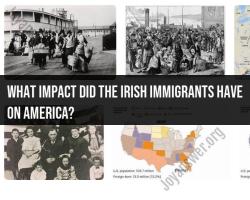What was the first great wave of immigration in America?
The "First Great Wave" of immigration to America generally refers to the period of significant immigration that occurred in the 19th century, particularly in the first half of the century. This wave of immigration was characterized by the arrival of large numbers of immigrants, primarily from Europe, who sought better economic opportunities, religious freedom, and escape from various social and political challenges in their home countries.
Key points about the First Great Wave of immigration to America include:
European Immigration: The majority of immigrants during this period came from various European countries, including Ireland, Germany, Italy, and the United Kingdom. Each group of immigrants had its own unique reasons for coming to America.
Irish Immigration: The Irish Potato Famine (1845-1852) played a significant role in driving Irish immigration to the United States. Famine, poverty, and lack of opportunities led many Irish to seek a better life in America.
German Immigration: Political unrest, economic hardship, and a desire for religious and political freedom prompted a substantial number of Germans to emigrate to the United States during this time.
Economic Factors: Economic opportunities in the United States, including jobs in agriculture, industry, and commerce, were a major pull factor for immigrants.
Social and Political Factors: Many immigrants were also escaping social and political challenges in their home countries, including religious persecution, wars, and political instability.
Westward Expansion: The opening of the American frontier during the 19th century also attracted immigrants looking for land and opportunities in the western United States.
Transatlantic Journey: Immigrants faced difficult and often perilous journeys across the Atlantic Ocean to reach America. These journeys were often marked by crowded and unsanitary conditions on ships.
The First Great Wave of immigration contributed significantly to the demographic and cultural diversity of the United States. It shaped the nation's growth, its labor force, and its cultural fabric. Many immigrant communities established themselves in urban areas, where they played a crucial role in the development of cities and the American economy.
This wave of immigration set the stage for subsequent waves of immigration in the late 19th and early 20th centuries, as well as shaping the modern immigration policies and patterns in the United States.
The First Great Wave of Immigration to America: A Historical Overview
The First Great Wave of immigration to America occurred between 1820 and 1880. During this time, over 10 million people immigrated to the United States, primarily from Germany, Ireland, and the United Kingdom.
There were a number of factors that drove immigration during the 19th century. These included:
- Economic opportunity. The United States was a rapidly growing economy in the 19th century, and there was a high demand for labor.
- Political and religious freedom. Many immigrants came to the United States seeking freedom from political and religious persecution in their home countries.
- Famine and disease. Many immigrants came to the United States to escape famine and disease in their home countries.
The First Great Wave of immigration had a profound impact on American culture and society. Immigrants brought with them their own languages, customs, and religions. They also played a major role in the development of the American economy.
The Factors Driving Immigration during the 19th Century
As mentioned above, the primary factors driving immigration to the United States during the 19th century were:
- Economic opportunity. The United States was a rapidly growing economy in the 19th century, and there was a high demand for labor in industries such as agriculture, construction, and manufacturing.
- Political and religious freedom. Many immigrants came to the United States seeking freedom from political and religious persecution in their home countries. For example, many Germans fled to the United States after the failed Revolutions of 1848, while many Irish fled during the Great Famine.
- Famine and disease. Many immigrants came to the United States to escape famine and disease in their home countries. For example, many Irish fled during the Great Famine, while many Germans fled during the Potato Famine.
In addition to these factors, many immigrants were also drawn to the United States by the promise of a better life. The United States was seen as a land of opportunity, where people could work hard and build a better future for themselves and their families.
The Cultural and Economic Contributions of the First Great Wave of Immigrants
Immigrants from the First Great Wave made significant contributions to American culture and society. They brought with them their own languages, customs, and religions, which enriched the American tapestry.
Immigrants also played a major role in the development of the American economy. They built railroads, canals, and factories. They also started their own businesses and contributed to the growth of American cities.
For example, German immigrants played a major role in the development of the American brewing industry. Irish immigrants played a major role in the construction of the American railroad system. And Italian immigrants played a major role in the development of the American restaurant industry.
Comparing Immigration Waves in U.S. History
There have been several major immigration waves in U.S. history. The First Great Wave, which occurred between 1820 and 1880, was the largest. Other major immigration waves include:
- The Second Great Wave, which occurred between 1880 and 1920, was primarily from Southern and Eastern Europe.
- The Post-World War II Wave, which occurred between 1945 and 1965, was primarily from Europe and Asia.
- The Recent Wave, which began in the 1960s, is primarily from Latin America and Asia.
Each immigration wave has had its own unique impact on American culture and society. For example, the Second Great Wave brought with it a new wave of languages, customs, and religions, while the Post-World War II Wave brought with it a new wave of scientists and engineers.
Legacy of the First Great Wave of Immigration in America
The First Great Wave of immigration had a profound impact on American culture and society. Immigrants brought with them their own languages, customs, and religions, which enriched the American tapestry.
Immigrants also played a major role in the development of the American economy. They built railroads, canals, and factories. They also started their own businesses and contributed to the growth of American cities.
Today, the descendants of immigrants from the First Great Wave make up a significant portion of the American population. Their contributions to American culture and society are still felt today.
For example, the St. Patrick's Day parade is a celebration of Irish heritage, while the Oktoberfest is a celebration of German heritage. Many American foods, such as the hamburger and the hot dog, were introduced to the United States by immigrants. And many American businesses, such as Anheuser-Busch and Heinz, were founded by immigrants.
The First Great Wave of immigration was a defining moment in American history. Immigrants from this era played a major role in shaping the country












